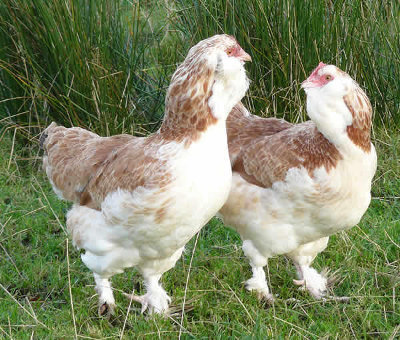Favorelle Chickens
Category: Standard Chickens

Facts about faverolle chickens. Faverolle chickens, also called the Faverolles chicken, is a French breed. The name comes from the village where they originated, Faverolles in Eure-et-Loire, France.
The Faverolle chicken has a bright red comb, white neck feathers, black cheecks, black and brown body and thick black and white tail fathers.
The Faverolle chicken is a mixture of several other breeds, such as the Brahma, French Rennes chicken, Dorking chicken and Houdan. This is why it has such varied plumage. As the distinct breed emerged in the late 1800s, individual birds still have variations in their coloring.
The Faverolle chickens were introduced to the U.S. around 1900. The U.S. breeds are overwhelmingly white and salmon. Salmon coloring, a mixture of honey gold and white feathers, is unique to the Favorelle breed. There are mahogany, white and beige birds as well. Male Faverolle chicken are darker than the females. The Faverolle chickens are unusual in that they have thick muffs. Roosters have bright colors, but Faverolles roosters are not as aggressive as some breeds. The Faverolle chicken have five toes on each foot. They have feathered legs. These birds do not have a crest.
The Faverolle chicken is primarily used for meat production and winter egg laying, though they have also been made for show. They have compact bodies that generate a lot of meat. Faverolles chickens mature early. The Faverolle chicken are good mothers and egg sitters. Females lay around 150 eggs per year, about four per week though some females manage five per week. The Faverolle chicken are one of the few breeds that will lay over the winter. Their eggs are light brown or otherwise “camouflage†colors. A few eggs are even pink.
They are hardy and they are a larger breed, with males reaching eight pounds (3.6 kg) and females six and a half pounds (2.9 kg). They handle confinement well.
The Faverolle chickens are very docile. They are easily handled and readily feed from your hand. However, they will be at the bottom of the pecking order of a mixed flock, so it may not be good to put them in a large mixed flock. The Faverolle chickens can be kept as loners.
Faverolle chickens tend to be broody and quirky, but they are generally submissive with other breeds. Because of their docility, these chickens are sometimes kept as pets.
Faverolle roosters are among the quietest available.

 Back To Category Standard Chickens
Back To Category Standard Chickens